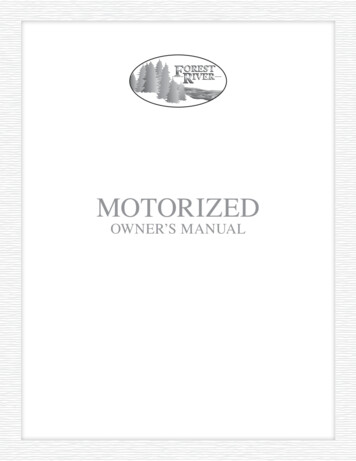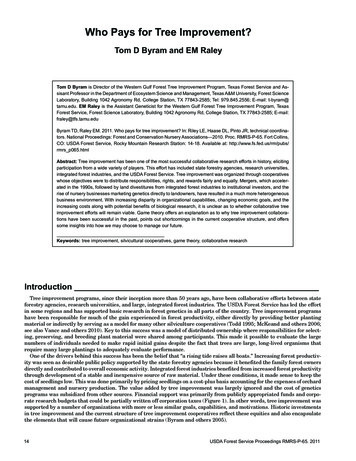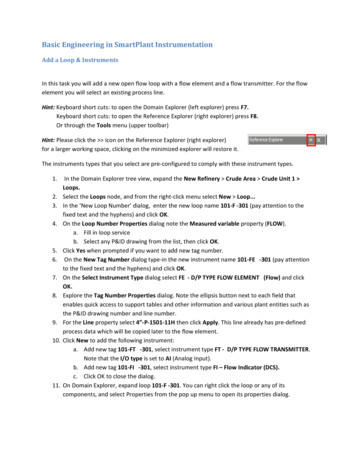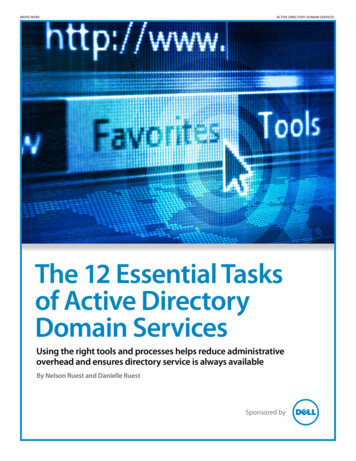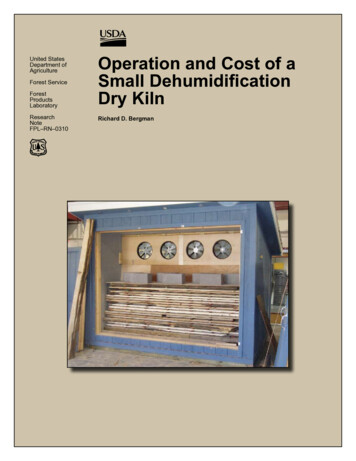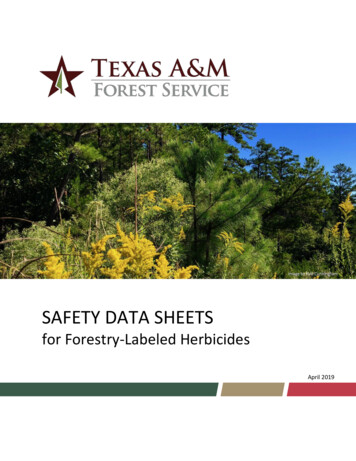
Transcription
Image by Kyle CunninghamSAFETY DATA SHEETSfor Forestry-Labeled HerbicidesApril 2019
How to Use this Reference ManualThis reference document provides Material Safety Data Sheets (MSDS) for most herbicidebrands labeled for forestry use by the brand’s herbicide chemical(s). If we were to provide theMaterial Safety Data Sheets (MSDS) for each of the herbicide brands labeled for forestry use,this document would be overly burdensome. For this reason, this reference manual lists oneand only one MSDS for each of the herbicide chemicals. The safety requirements will be similarenough for a specific chemical derivative (e.g., acid, amine, ester, choline, etc.). If the safetyrequirements differ by chemical derivative then additional MSDS sheets are provided for thosederivatives. For example the amine derivative of triclopyr has additional safety concernsbeyond that of the ester or choline derivative of triclopyr. As such two MSDS are provided.Steps1. Locate the Brand Name(s) in the table of contents and determine the correspondingherbicide chemical and page number.Example: Polaris AC includes the herbicide imazapyr listed on page 1012. Turn to the appropriate page and review the basic information about the herbicidechemical includinga. target plant groupsb. resistant plant groupsc. brand characteristicsd. special notese. signal word andf. use statement.3. Turn to the next page to read a representative MSDS for all brands using that herbicidechemical(s) and derivative.Example: Page 102 provide MSDS for Arsenal AC which representative of Polaris AC andother brands.4. Read the safety requirements thoroughly and review important first-aid measures.Sources of Information for this handbook include labels, material safety data sheets and publications of herbicide and equipment manufacturers. Theinformation given herein is for education purposes only. Reference to commercial products or trade names or manufacturer’s names in this publicationdoes not constitute an official endorsement or approval by Texas A&M AgriLife Extension Service, Texas A&M Forest Service, University of Arkansas, orthe author of any product or service to the exclusion of any others that may also be suitable .
Globally Harmonized System (GHS) Hazard PictogramsExplosive Explosive Self-reactive Organic PeroxidesFlammable FlammablesPyrophoricSelf-heatingEmits Flammable GasSelf-reactiveOrganic PeroxidesOxidizing OxidizersCompressed Gas Gases Under PressureHarmful Irritant (skin and eye)Skin SensitizerAcute Toxicity (harmful)Narcotic effectsRespiratory Tract IrritantHazardous to Ozone CarcinogenMutagenicityReproductive ToxicityRespiratory SensitizerTarget Organ ToxicityAspiration ToxicityCorrosive Skin Corrosion / Burns Eye Damage Corrosive to MetalsToxic Acute Toxicity (fatal or toxicHealth HazardEnvironmental Hazard Acute Toxicity (fatal or toxic)
Table of ContentsBrand NameAccord XRT IIArrow 2ECArsenal ACAtrazine 4LAtrazine 90DFBoulder 63Brush-RhapCapstoneChopper Gen2Clean SlateCleantraxxClearcastClethodim 2EClopyralid 3DakotaDetailElement 3AElement 4Envoy PlusEscort XPEsplanade FForestersFormula 40FreelexxFusilade DXFusilade IIGarlon 3AGarlon 4 UltraGarlon XRTGlyphosate 54Goal 2XLGraslan LImazapyr 2SLImazapyr 4SLIntensity 1Krenite SActive geNumber7533atrazinetriclopyrdicamba & 2,4-Daminopyralid & ofen & ufenaciltriclopyrtriclopyrclethodimmetsulfuron phosateoxyfluorfen75141picloram & 025
Lineage ClearstandMad Dog 54Mad Dog PlusMakazeMilestoneMilestone VM PlusMSM 60DFOpensightOust ExtraOust XPOustartPathfinder IIPathwayPatriotPicloram 22KPicloram Plus DPolaris ACPolaris SPPrep-ItPrononeRazorRazor ProRelegate RTURodeoRotary 2SLRoundup CustomRoundup Pro ConcentrateRoundup ProMaxSelect 2EC,Select MaxSFM 75SFM ExtraSpitfireSpyderSpyder ExtraSterling BlueStingerTahoe 3ATordon 101imazapyr & metsulfuron inopyralid & triclopyrmetsulfuron methylaminopyralid & metsulfuron methylsulfometuron methyl & metsulfuron methylsulfometuron methylhexazinone & sulfometuron methyltriclopyrpicloram & 2,4-Dmetsulfuron methylpiclorampicloram & 2,4-Dimazapyrimazapyrimazapyr & on methyl33199sulfometuron methyl & metsulfuron methyldicamba & 2,4-D330262sulfometuron methylsulfometuron methyl & metsulfuron methyl199330dicamba54clopyralidtriclopyrpicloram & 2,4-D340209314
Tordon 22KTranslineTriclopyr 3Triclopyr 4Triclopyr RTUTrooper P DVanquishVastlanVelossaVelpar DFVelpar LWeberan clopyr16140209219triclopyrpicloram & nehexazinonedicamba & 2,4-Ddicamba & 2,4-D2,4-D87878726226254
2,4-DTarget Plants: Many annual and perennial broadleaf weeds, vines, and somewoody plants when actively growing.Resistant Plants: Red maple, ash, elm, persimmon, some oaks/hickories,blackberry. No impact to grasses. Can be applied over conifersonce hardened off.Brands: 2,4-D Amine, Freelexx, Weedone, Formula 40Signal Word: DANGER(on at least one product)Use Statement: General Use5
SAFETY DATA SHEETFormula 401. CHEMICAL PRODUCT AND COMPANY IDENTIFICATIONProduct Name:EPA Reg. No.:Product Type:Formula 40Company Name:Nufarm Americas Inc11901 S. Austin AvenueAlsip, IL 608031-800-345-3330228-357HerbicideTelephone Numbers: For Chemical Emergency, Spill, Leak, Fire, Exposure, or Accident,Call CHEMTREC Day or Night: 1-800-424-9300For Medical Emergencies Only, Call 1-877-325-1840This product is an EPA FIFRA registered pesticide. Some classifications on this SDS are not the same asthe FIFRA label. Certain sections of this SDS are superseded by federal law governed by EPA for aregistered pesticide. Please see Section 15. REGULATORY INFORMATION for explanation.2. HAZARDS IDENTIFICATIONPHYSICAL HAZARDS:Flammable LiquidCategory 4HEALTH HAZARDS:Acute Toxicity OralEye DamageSkin IrritationSkin SensitizationCategory 4Category 1Category 2Category 1ENVIRONMENTAL HAZARDS:Hazardous to aquatic environment, acuteHazardous to aquatic environment, chronicCategory 2Category 3SIGNAL WORD:DANGERHAZARD STATEMENTS:Combustible liquid. Harmful if swallowed. Causes serious eye damage. Causes skin irritation. May cause anallergic skin reaction. Toxic to aquatic life. Harmful to aquatic life with long lasting effects.PRECAUTIONARY STATEMENTSKeep away from flames and hot surfaces. No smoking. Wash thoroughly after handling. Do not eat, drink orsmoke when using this product. Avoid breathing mist, vapors, or spray. Wear protective gloves and eyeprotection. Contaminated work clothing should not be allowed out of the workplace. Avoid release to theenvironment.IF SWALLOWED: Call a POISON CENTER or doctor if you feel unwell. Rinse mouth.In case of fire: Use dry chemical or carbon dioxide.IF IN EYES: Rinse cautiously with water for several minutes. Remove contact lenses, if present and easy to do.Continue rinsing. Immediately call a POISON CENTER.May 10, 2015Page 1 of 76
SAFETY DATA SHEETFormula 40IF ON SKIN: Wash with plenty of water. If skin irritationcontaminated clothing and wash it before reuse.or rash occurs: Get medical advice.Take offCollect spillage.Store in a well-ventilated place. Keep cool.Dispose of contents in accordance with local, state, and federal regulations.3. COMPOSITION / INFORMATION ON INGREDIENTSCOMPONENTDimethylamine Salt of 2,4-Dichlorophenoxyacetic AcidTriisopropanolamine Salt of 2,4-Dichlorophenoxyacetic AcidOther IngredientsSynonyms:CAS NO.2008-39-132341-80-3Trade Secret% BY WEIGHT21.3 – 22.733 – 35Trade SecretMixture containing 2,4-D TIPA and 2,4-D DMA salts; Triisopropanolamine Salt andDimethylamine Salt of 2,4-Dichlorophenoxyacetic acidIngredients not precisely identified are proprietary or non-hazardous. Values are not product specifications.4. FIRST AID MEASURESIf in Eyes: Hold eye open and rinse slowly and gently with water for 15 to 20 minutes. Remove contact lenses, ifpresent, after the first 5 minutes, then continue rinsing eye. Get immediate medical attention.If on Skin or Clothing: Take off contaminated clothing. Rinse skin immediately with plenty of water forseveralminutes. If irritation or rash occurs, get medical advice.If Swallowed: Have person sip a glass of water if able to swallow. Do not induce vomiting unless told to do so bythe poison control center or doctor. Do not give anything by mouth to an unconscious person. If symptomsdevelop, get medical advice.If Inhaled: Move person to fresh air. If breathing is difficult, administer oxygen. If symptoms develop, get medicaladvice.Most important symptoms/effects, acute and delayed: Causes severe eye irritation with possible eyedamage. Causes skin irritation. May be harmful if swallowed. Causes allergic skin reaction (sensitization).Indication of immediate medical attention and special treatment needed, if necessary: Get immediatemedical attention for eye contact. For ingestion there is no specific antidote available. Treat symptomatically.5. FIRE FIGHTING MEASURESExtinguishing Media: Recommended for large fires: foam or water spray. Recommended for small fires: drychemical or carbon dioxide.Special Fire Fighting Procedures: Firefighters should wear NIOSH approved self-contained breathingapparatus and full fire-fighting turn out gear. Dike area to prevent runoff and contamination of water sources.Dispose of fire control water later.Unusual Fire and Explosion Hazards: If water is used to fight fire, contain runoff, using dikes to preventcontamination of water supplies. Dispose of fire control water later.Hazardous Decomposition Materials (Under Fire Conditions): May produce gases such as hydrogen chlorideand oxides of carbon and nitrogen.6. ACCIDENTAL RELEASE MEASURESPersonal Precautions: Wear appropriate protective gear for the situation. See Personal Protection information inSection 8.Environmental Precautions: Prevent material from entering public sewer systems or any waterways. Do notflush to drain. Large spills to soil or similar surfaces may necessitate removal of topsoil. The affected area shouldbe removed and placed in an appropriate container for disposal.Methods for Containment: Dike spill using absorbent or impervious materials such as earth, sand or clay.Collect and contain contaminated absorbent and dike material for disposal.Methods for Cleanup and Disposal: Pump any free liquid into an appropriate closed container. Collectwashings for disposal. Decontaminate tools and equipment following cleanup. See Section 13: DISPOSALCONSIDERATIONS for more information.Other Information: Large spills may be reportable to the National Response Center (800-424-8802) and to stateand/or local agencies.May 10, 2015Page 2 of 77
SAFETY DATA SHEETFormula 407. HANDLING AND STORAGEHANDLING:Keep out of reach of children. Causes eye damage and skin irritation. Harmful if swallowed. May cause allergicreaction in susceptible individuals. Avoid contact with eyes, skin and clothing. Users should wash hands beforeeating, drinking, chewing gum, using tobacco, or using the toilet.STORAGE:Do not store below temperature of 40 F (7 C). If frozen (crystallized), warm to 80-90 F (27-32 C) and redissolvebefore using by rolling or shaking the container. Store in a safe manner. Store in cool, dry place in originalcontainer only. Keep container tightly closed when not in use. Reduce stacking height where local condition canaffect packaging strength. See product label for handling/storage precautions relative to the end use of thisproduct.8. EXPOSURE CONTROLS / PERSONAL PROTECTIONEngineering Controls:Where engineering controls are indicated by specific use conditions or a potential for excessive exposure, uselocal exhaust ventilation at the point of generation.Personal Protective Equipment:Eye/Face Protection: To avoid contact with eyes, wear face shield or goggles. An emergency eyewash or watersupply should be readily accessible to the work area.Skin Protection: To avoid contact with skin, wear long pants, long-sleeved shirt, socks, shoes and chemicalresistant gloves. An emergency shower or water supply should be readily accessible to the work area.Respiratory Protection: Not normally required. If mists exceed acceptable levels, wear NIOSH approved airpurifying respirator with cartridges/canisters approved for use against pesticides.General Hygiene Considerations: Personal hygiene is an important work practice exposure control measureand the following general measures should be taken when working with or handling this material: 1) do not store,use and/or consume foods, beverages, tobacco products, or cosmetics in areas where this material is stored; 2)wash hands and face carefully before eating, drinking, using tobacco, applying cosmetics or using the toilet.Exposure Guidelines:OSHAComponentTIPA Salt of 2,4-DDMA Salt of 2,4-DOther Ingredients*Based on adopted limit for 2,4-DNE Not EstablishedTWA10*10*NEACGIHSTELNENENETWA10*10*NE9. PHYSICAL AND CHEMICAL PROPERTIESAppearance:Odor:Odor threshold:pH:Melting point/freezing point:Initial boiling point and boiling rangeFlash point:Evaporation rate:Flammability (solid, gas):Upper/lower flammability or explosive limits:Vapor pressure:Vapor density:Relative density:Solubility(ies):Partition coefficient: n-octanol/water:Autoignition temperature:Decomposition temperature:May 10, 2015Translucent amber liquidPhenolic-likeNot determinedNot determinedNot determinedNot determined191 F (88º C) TCCNot determinedNot determinedNot applicableNot determinedNot determined1.18 – 1.25(water) infiniteNot determinedNo data availableNo data availablePage 3 of 78STELNENENEUnitmg/m3mg/m3
SAFETY DATA SHEETViscosity:Formula 40Not determinedNote: Physical data are typical values, but may vary from sample to sample. A typical value should not beconstrued as a guaranteed analysis or as a specification.10. STABILITY AND REACTIVITYReactivity: This product is not normally reactive.Chemical Stability: This material is stable under normal handling and storage conditions.Possibility of Hazardous Reactions: Hazardous polymerization will not occur.Conditions to Avoid: Excessive heat. Do not store near heat or flame. Avoid temperatures near or above flashpoint.Incompatible Materials: Strong oxidizing agents: bases and acids.Hazardous Decomposition Products: Under fire conditions may produce gases such as hydrogen chloride andoxides of carbon and nitrogen.11. TOXICOLOGICAL INFORMATIONLikely Routes of Exposure: Inhalation, eye and skin contact.Symptoms of Exposure:Eye Contact: May cause severe irritation with corneal injury, which may result in permanent impairment ofvision, even blindness. Chemical burns may occur.Skin Contact: Slightly irritating to the skin. Skin contact may cause allergic reaction. Prolonged skin contact isunlikely to result in absorption of harmful amounts.Ingestion: Harmful if swallowed. May cause nausea, vomiting, abdominal pain, decreased blood pressure,muscle weakness, muscle spasms.Inhalation: May be harmful if inhaled. May cause upper respiratory tract irritation and symptoms similar to thosefrom ingestion.Delayed, immediate and chronic effects of exposure: None reported.Toxicology DataData from laboratory studies conducted on a similar, but not identical, formulation:Oral: Rat LD50: 866 mg/kg (males); 1058 mg/kg (females)Dermal: Rat LD50: 2,000 mg/kgInhalation: Rat 4-hr LC50: 8.2 mg/LEye Irritation: Rabbits: Severely irritating/corrosiveSkin Irritation: Rabbits: Slightly irritatingSkin Sensitization: Not a contact sensitizer in guinea pigs following repeated skin exposure.Subchronic (Target Organ) Effects: Repeated overexposure to phenoxy herbicides may cause effects to liver,kidneys, blood chemistry, and gross motor function. Rare cases of peripheral nerve damage have been reported,but extensive animal studies have failed to substantiate these observations, even at high doses for prolongedperiods.Carcinogenicity / Chronic Health Effects: Prolonged overexposure can cause liver, kidney and muscledamage. The International Agency for Research on Cancer (IARC) lists exposure to chlorophenoxy herbicides asa class 2B carcinogen, the category for limited evidence for carcinogenicity in humans. However, more current2,4-D lifetime feeding studies in rats and mice did not show carcinogenic potential. The U.S. EPA has given 2,4-Da Class D classification (not classifiable as to human carcinogenicity).Reproductive Toxicity: No impairment of reproductive function attributable to 2,4-D has been noted inlaboratory animal studies.Developmental Toxicity: Studies in laboratory animals with 2,4-D have shown decreased fetal body weights anddelayed development in the offspring at doses toxic to mother animals.Genotoxicity: There have been some positive and some negative studies, but the weight of evidence is that 2,4D is not mutagenic.ASSESSMENT CARCINOGENICITY:This product contains substances that are considered to be probable or suspected human carcinogens asfollows:Regulatory Agency Listing As CarcinogenMay 10, 2015Page 4 of 79
SAFETY DATA SHEETFormula 40ComponentACGIHChlorophenoxy Herbicides (2,4-D salts)NoOther IngredientsNoIARC Group 2B: Possibly carcinogenic to humansIARC2BNoNTPNoNoOSHANoNo12. ECOLOGICAL INFORMATIONEcotoxicity:Data on TIPA Salt of 2,4-D Acid:Bluegill Acute LC50:Rainbow Trout Acute LC50:Daphnia Acute LC50:432 mg/l317 mg/l748 mg/lData on 2,4-D, Dimethylamine Salt:96-hour LC50 Bluegill:96-hour LC50 Rainbow Trout:48-hour EC50 Daphnia:524 mg/l250 mg/l184 mg/lPink Shrimp Acute LC50:Tidewater Silverside Acute LC50:Growth Inhibition EC50 Green Algae:Bobwhite Quail Oral LD50:Mallard Duck 8-day Dietary LC50:744 mg/l376 mg/l103 mg/l500 mg/kg 5,620 ppmEnvironmental Fate:In laboratory and field studies, 2,4-D salts rapidly dissociate to parent acid in the environment. The typical half-lifeof the resultant 2,4-D acid ranged from a few days to a few weeks.13. DISPOSAL CONSIDERATIONSWaste Disposal Method:Pesticide wastes are toxic. If container is damaged or if pesticide has leaked, contain all spillage. Place in aclosed, labeled container for proper disposal. Improper disposal of excess pesticide, spray mixtures, or rinsate isa violation of Federal law and may contaminate groundwater. If these wastes cannot be disposed of by useaccording to label instructions, contact your State Pesticide or Environmental Control Agency, or the HazardousWaste Representative at the nearest EPA regional office for guidance.Container Handling and Disposal:Nonrefillable Containers 5 Gallons or Less: Nonrefillable container. Do not reuse or refill this container.Offer for recycling if available. Triple rinse container (or equivalent) promptly after emptying.Triple rinse as follows: Empty the remaining contents into application equipment or a mix tank and drain for10 seconds after the flow begins to drip. Fill the container 1/4 full with water and recap. Shake for 10 seconds.Pour rinsate into application equipment or a mix tank or store rinsate for later use or disposal. Drain for 10seconds after the flow begins to drip. Repeat this procedure two more times. Then offer for recycling orreconditioning, or puncture and dispose of in a sanitary landfill, or by other procedures approved by State andlocal authorities. Plastic containers are also disposable by incineration, or, if allowed by State and localauthorities, by burning. If burned stay out of smoke.Nonrefillable containers larger than 5 gallons: Nonrefillable container. Do not reuse or refill this container. Offerfor recycling if available. If recycling or reconditioning not available, puncture and dispose of in a sanitarylandfill, or by other procedures approved by State and local authorities. Plastic containers are also disposableby incineration, or, if allowed by State and local authorities, by burning. If burned stay out of smoke. Triplerinse or pressure rinse container (or equivalent) promptly after emptying.Triple rinse as follows: Empty the remaining contents into application equipment or a mix tank. Fill thecontainer 1/4 full with water. Replace and tighten closures. Tip container on its side and roll it back and forth,ensuring at least one complete revolution, for 30 seconds. Stand the container on its end and tip it back andforth several times. Turn the container over onto its other end and tip it back and forth several times. Emptythe rinsate into application equipment or a mix tank or store rinsate for later use or disposal. Repeat thisprocedure two more times.Pressure rinse as follows: Empty the remaining contents into application equipment or a mix tank andcontinue to drain for 10 seconds after the flow begins to drip. Hold container upside down over applicationequipment or mix tank or collect rinsate for later use or disposal. Insert pressure rinsing nozzle in the side ofthe container, and rinse at about 40 psi for at least 30 seconds. Drain for 10 seconds after the flow begins todrip.May 10, 2015Page 5 of 710
SAFETY DATA SHEETFormula 4014. TRANSPORTATION INFORMATIONFollow the precautions indicated in Section 7: HANDLING AND STORAGE of this SDS.DOT17 gallons per complete packageNon Regulated17 gallons per complete packageUN 3082, Environmentally hazardous substances, liquid, n.o.s. (2,4-D Salts), 9, III, RQ,IMDGNon RegulatedIATANon Regulated15. REGULATORY INFORMATIONEPA FIFRA INFORMATIONThis chemical is a pesticide product registered by the United States Environmental Protection Agency and issubject to certain labeling requirements under federal pesticide law. These requirements differ from theclassification criteria and hazard information required for safety data sheets (SDS), and for workplace labels ofnon-pesticide chemicals. The hazard information required on the pesticide label is reproduced below. Thepesticide label also includes other important information, including directions for use.DANGER. Corrosive. Causes irreversible eye damage. May be fatal if absorbed through skin. Harmful ifswallowed. Do not get in eyes, on skin or clothing. Prolonged or frequently repeated skin contact may causeallergic reactions in some individuals.U.S. FEDERAL REGULATIONSTSCA Inventory: This product is exempted from TSCA because it is solely for FIFRA regulated use.SARA Hazard Notification/Reporting:Hazard Categories Under Criteria of SARA Title III Rules (40 CFR Part 370):Acute Health, Fire HazardSection 313 Toxic Chemical(s):NoneReportable Quantity (RQ) under U.S. CERCLA:NoneRCRA Waste Code:Under RCRA, it is the responsibility of the product user to determine at the time of disposal, whether a materialcontaining the product or derived from the product should be classified as a hazardous waste.State Information:Other state regulations may apply. Check individual state requirements.California Proposition 65: Not listed16. OTHER INFORMATIONNational Fire Protection Association (NFPA) Hazard Rating:Rating for this product: Health: 3Flammability: 2Reactivity: 0Hazards Scale: 0 Minimal 1 Slight 2 Moderate 3 Serious 4 SevereThis Safety Data Sheet (SDS) serves different purposes than and DOES NOT REPLACE OR MODIFY THE EPAACCEPTED PRODUCT LABELING (attached to and accompanying the product container). This SDS providesimportant health, safety and environmental information for employers, employees, emergency responders andMay 10, 2015Page 6 of 711
SAFETY DATA SHEETFormula 40others handling large quantities of the product in activities generally other than product use, while the labelingprovides that information specifically for product use in the ordinary course.Use, storage and disposal of pesticide products are regulated by the EPA under the authority of the FederalInsecticide, Fungicide, and Rodenticide Act (FIFRA) through the product labeling, and all necessary andappropriate precautionary, use, storage, and disposal information is set forth on that labeling. It is a violation ofFederal law to use a pesticide product in any manner not prescribed on the EPA-accepted label.Although the information and recommendations set forth herein (hereinafter “Information”) are presented in goodfaith and believed to be correct as of the date hereof, Nufarm Americas Inc. makes no representations as to thecompleteness or accuracy thereof. Information is supplied upon the condition that the persons receiving same willmake their own determination as to its suitability for their purposes prior to use. In no event will Nufarm AmericasInc. be responsible for damages of any nature whatsoever resulting from the use of or reliance upon Information.NO REPRESENTATIONS OR WARRANTIES, EITHER EXPRESS OR IMPLIED, OF MERCHANTABILITY,FITNESS FOR A PARTICULAR PURPOSE OR OF ANY OTHER NATURE ARE MADE HEREUNDER WITHRESPECT TO INFORMATION OR THE PRODUCT TO WHICH INFORMATION REFERS AND ALL SUCHWARRANTIES ARE HEREBY SPECIFICALLY DISCLAIMED.Date of Issue:May 10, 2015May 10, 2015Supersedes:Page 7 of 712October 11, 2013
aminopyralidTarget Plants: Many annual, biennial, and perennial broadleaf weeds includingthistle spp., ragweed, marestail, as well as woody plants in thelegume family such as mimosa, redbud, and locust spp. Kudzu,Wisteria, and Japanese Stiltgrass.Resistant Plants: Many woody plants. Highest efficacy as a tank mix partner.Dogfennel, wild carrot, plaintain, goldenrod, vervain, broomsnakeweed, toadflax.Brands: MilestoneSignal Word: CAUTIONUse Statement: General Use13
SAFETY DATA SHEETDOW AGROSCIENCES LLCIssue Date: 05/26/2015Print Date: 05/26/2015Product name: MILESTONE HerbicideDOW AGROSCIENCES LLC encourages and expects you to read and understand the entire (M)SDS,as there is important information throughout the document. We expect you to follow the precautionsidentified in this document unless your use conditions would necessitate other appropriate methods oractions.1. IDENTIFICATIONProduct name: MILESTONE HerbicideRecommended use of the chemical and restrictions on useIdentified uses: End use herbicide productCOMPANY IDENTIFICATIONDOW AGROSCIENCES LLC9330 ZIONSVILLE RDINDIANAPOLIS IN 46268-1053UNITED STATESCustomer Information Number:800-992-5994info@dow.comEMERGENCY TELEPHONE NUMBER24-Hour Emergency Contact: 800-992-5994Local Emergency Contact: 352-323-35002. HAZARDS IDENTIFICATIONHazard classificationThis material is not hazardous under the criteria of the Federal OSHA Hazard CommunicationStandard 29CFR 1910.1200.Other hazardsno data available3. COMPOSITION/INFORMATION ON INGREDIENTSThis product is a mixture.ComponentCASRNAminopyralid Triisopropanolamine Salt566191-89-714 Trademark of Dow AgroSciencesLLCConcentration40.6%Page 1 of 10
Issue Date: 05/26/2015Product name: MILESTONE HerbicideTriisopropanolamine122-20-31.5%BalanceNot available57.9%4. FIRST AID MEASURESDescription of first aid measuresGeneral advice: If potential for exposure exists refer to Section 8 for specific personal protectiveequipment.Inhalation: Move person to fresh air. If person is not breathing, call an emergency responder orambulance, then give artificial respiration; if by mouth to mouth use rescuer protection (pocket masketc). Call a poison control center or doctor for treatment advice.Skin contact: Take off contaminated clothing. Rinse skin immediately with plenty of water for 15-20minutes. Call a poison control center or doctor for treatment advice.Eye contact: Hold eyes open and rinse slowly and gently with water for 15-20 minutes. Removecontact lenses, if present, after the first 5 minutes, then continue rinsing eyes. Call a poison controlcenter or doctor for treatment advice.Ingestion: No emergency medical treatment necessary.Most important symptoms and effects, both acute and delayed: Aside from the information foundunder Description of first aid measures (above) and Indication of immediate medical attention andspecial treatment needed (below), any additional important symptoms and effects are described inSection 11: Toxicology Information.Indication of any immediate medical attention and special treatment neededNotes to physician: No specific antidote. Treatment of exposure should be directed at the control ofsymptoms and the clinical condition of the patient. Have the Safety Data Sheet, and if available, theproduct container or label with you when calling a poison control center or doctor, or going fortreatment.5. FIREFIGHTING MEASURESSuitable extinguishing media: To extinguish combustible residues of this product use water fog,carbon dioxide, dry chemical or foam.Unsuitable extinguishing media: no data availableSpecial hazards arising from the substance or mixtureHazardous combustion products: Under fire conditions some components of this product maydecompose. The smoke may contain unidentified toxic and/or irritating compounds. Combustionproducts may include and are not limited to: Nitrogen oxides. Hydrogen chloride. Carbon monoxide.Carbon dioxide.Unusual Fire and Explosion Hazards: This material will not burn until the water has evaporated.Residue can burn.Advice for firefighters15Page 2 of 10
Issue Date: 05/26/2015Product name: MILESTONE HerbicideFire Fighting Procedures: Keep people away. Isolate fire and deny unnecessary entry. Toextinguish combustible residues of this product use water fog, carbon dioxide, dry chemical or foam.Contain fire water run-off if possible. Fire water run-off, if not contained, may cause environmentaldamage. Review the “Accidental Release Measures” and the “Ecological Information” sections of this(M)SDS.Special protective equipment for firefighters: W
herbicide chemical and page number. Example: Polaris AC includes the herbicide imazapyr listed on page 101 2. Turn to the appropriate page and review the basic information about the herbicide chemical including a. target plant groups b. resistant plant groups c. brand characteristics



